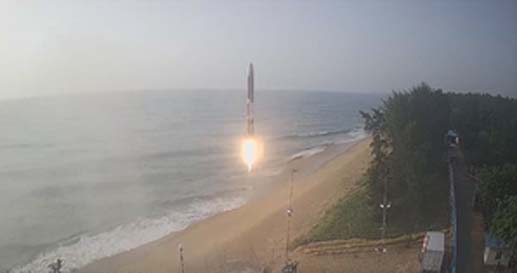In a significant development in the realm of space exploration, Agnikul Cosmos, a space venture based in Chennai, has achieved a notable feat by conducting a sub-orbital test-flight of its proprietary 3D-printed semi-cryogenic rocket named Agnibaan. This successful endeavor took place at the company’s private launch facility situated in Sriharikota, thereby establishing Agnikul Cosmos as the second private entity in India to accomplish such a milestone.
Following four previous unsuccessful attempts, Thursday witnessed the culmination of the test-flight, albeit without any live broadcast and with limited attendance of dignitaries at the Sriharikota launch complex within the confines of ISRO’s Satish Dhawan Space Centre.
Acknowledging this achievement, the Indian Space Research Organisation (ISRO) lauded Agnikul Cosmos through a post on X, hailing it as a pioneering event marking the maiden controlled flight of a semi-cryogenic liquid engine manufactured via additive processes.
Expressing jubilation, Pawan Goenka, Chairman of the Indian National Space Promotion and Authorisation Centre (IN-SPACe), commended the successful launch of Agnibaan SOrTeD, emphasizing its historic significance in India’s space endeavors. He underscored the groundbreaking nature of this accomplishment, propelled by the utilization of the world’s premier single-piece 3D-printed semi-cryogenic engine, as a testament to the ingenuity of India’s burgeoning cadre of innovators.
This endeavor by Agnikul marked its fifth endeavor to launch the Agnibaan Sub-Orbital Technology Demonstrator (SOrTeD) since its initiation on March 22.
Lt Gen A K Bhatt (retd), Director General of the Indian Space Association (ISpA), hailed this achievement as a monumental milestone, heralding a new era for India’s burgeoning private space industry. He extended hearty congratulations to the entire team involved and offered best wishes for their forthcoming endeavors.
Agnibaan stands out as a versatile, two-stage launch platform with a payload capacity of up to 300 kg into an orbit approximately 700 km above the Earth’s surface, as per the company’s specifications. The rocket harnesses the power of a semi-cryogenic engine employing a blend of liquid and gaseous propellants, a technology yet to be demonstrated by the Indian Space Research Organisation (ISRO) in any of its projects.
The SOrTeD mission represents a single-stage launch vehicle demonstration powered by the Agnilet, a sub-cooled liquid oxygen-based propulsion system developed domestically. Agnikul Cosmos has equipped the vehicle with an innovative ethernet-based avionics architecture and autonomously developed autopilot software.
Fueled by sub-cooled Liquid Oxygen (LOX) and Aviation Turbine Fuel (ATF), the vehicle boasts four carbon composite fins for passive control. The Agnilet engine stands as the world’s premier single-piece 3D-printed semi-cryogenic rocket engine.
The mission is anticipated to endure slightly over two minutes from liftoff to splashdown. Post-launch, the vehicle is slated to execute a pitch-over maneuver roughly four seconds into the flight, involving a controlled rotation to alter its orientation from vertical to a predetermined angle relative to the ground or its flight trajectory.
Subsequently, the vehicle will undergo a wind-biasing maneuver at approximately 39 seconds post-launch, aimed at compensating for wind-induced trajectory deviations during ascent. Anticipated to reach apogee at 1 minute 29 seconds, the launch vehicle will descend to splashdown just over two minutes into the flight, marking the culmination of the mission.









